
Books on Happiness / The Definitive Book Of Body Language- 2 students
.pdf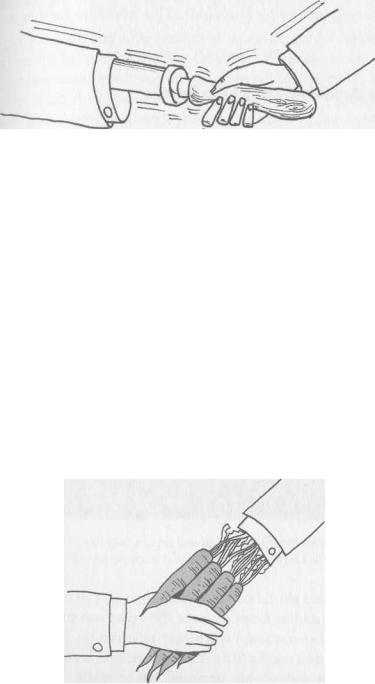
The Power Is in Your Hands
The Pump Handle
Occasionally, the pumper will cease pumping but continue to hold the receiver's hand to prevent their escape and, interestingly, few people try to pull their hand away. The act of being physically connected seems to weaken our resolve to retreat.
8.The Dutch Treat
Credibility Rating: 2/10.
Being somewhat vegetarian in approach, this handshake has its origins in the Netherlands, where a person can be accused of 'Geeft 'n hand als bosje worteljes' meaning 'Giving a handshake like a bunch of carrots'. It's a distant relative of the Wet Fish but stiffer and less clammy to the touch.
The Dutch Treat
63
The Power Is in Your Hands
Summary
Few people have any idea how they come across to others in initial meetings, despite the fact that most of us are aware that the first few minutes of that meeting can make or break a relationship. Take the time to practise handshake styles with your friends and colleagues and you can quickly learn how to deliver a positive handshake every time. Keeping the palms held vertical and matching the other person's grip is usually perceived as a 10/10 handshake.
65

Chapter 3
THE MAGIC OF SMILES
AND LAUGHTER
What makes this one of the world's most irresistible icons?
Bob gazed across the room and locked eyes with an attractive brunette. She seemed to smile at him and, not being slow on the uptake, he swiftly crossed the room and began a conversation with her. She didn't seem to talk much but she was still smiling at him so he persisted. One of his female friends sauntered past and whispered, 'Forget it Bob...she thinks you're a jerk.' He was stunned. But she was still smiling at him! As with most men, Bob didn't understand the negative significance of the tight-lipped, no-teeth-visible female smile.
Children were often told by their grandmothers to 'put on a happy face', 'wear a big smile' and 'show your pearly 'whites' when meeting someone new because Grandma knew, on an intuitive level, it would produce a positive reaction in others.
The first recorded scientific studies into smiling were in the
66
The Magic of Smiles and Laughter
early part of the nineteenth century when French scientist Guillaume Duchenne de Boulogne used electrodiagnostics and electrical stimulation to distinguish between the smile of real enjoyrnent and other kinds of smiling. He analysed the heads of people executed by guillotine to study how the face muscles worked. He pulled face muscles from many different angles to catalogue and record which muscles caused which smiles. He discovered that smiles are controlled by two sets of muscles: the zygomatic major muscles, which run down the side of the face and connect to the corners of the mouth and the orbicularis oculi, which pull the eyes back. The zygomatic majors pull the mouth back to expose the teeth and enlarge the cheeks, while the orbicularis oculi make the eyes narrow and cause 'crow's feet'. These muscles are important to understand because the zygomatic majors are consciously controlled - in other words, they are used to produce false smiles of fake enjoyment to try to appear friendly or subordinate. The orbicularis oculi at the eyes act independently and reveal the true feelings of a genuine smile. So the first place to check the sincerity of a smile is to look for wrinkle lines beside
the eyes.
A natural smile produces characteristic wrinkles around the eyes - insincere people smile only with their mouth.
In the enjoyment smile, not only are the lip corners pulled up, but the muscles around the eyes are contracted, while nonenjoyment smiles involve just the smiling lips.
67
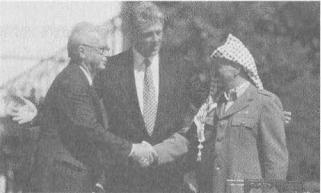
The Definitive Book of Body Language
It has been superseded in younger generations by De Slappe Vaatdoek, or Sloppy Dishcloth. This needs no further explanation.
The Arafat-Rabin Handshake
The photograph below shows the late Israeli Prime Minister, Yitzhak Rabin and Palestinian Chairman Yassar Arafat shaking hands at the White House in 1993 and it reveals several interesting attitudes. President Clinton is, in fact, the key figure in the shot because of his unobstructed centre position, extra height and Arms-Spread-Open-Palms gesture, reminiscent of a god presiding over his people. Clinton's HalfMoon, Lips-Sucking smile shows the emotional restraint he either felt or faked.
Yitzhak Rabin (left) holds his ground using a Stiff-Arm Thrust to resist being pulled forward as Yassar Arafat attempts a Bent-Arm-Pull-In
In this famous shot, both men keep their feet firmly planted on the ground and attempt to force the other out of his territoryYitzhak Rabin assumed the power position on the left side of the picture and used a Stiff-Arm Thrust and leaned forward to keep Arafat out of his personal space while Yassar Arafat stood absolutely erect and attempted to counter with a Bent- Arm-Pull-in.
64
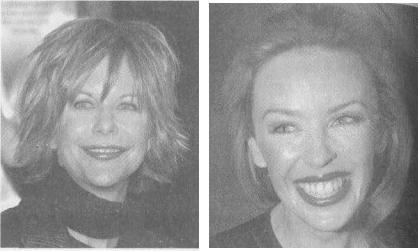
The Definitive Book of Body Language
Which smile is fake?
False smiles pull back only the mouth, real smiles pull back both the mouth and eyes
Scientists can distinguish between genuine and fake smiles by using a coding system called the Facial Action Coding System (FACS), which was devised by Professor Paul Ekman of the University of California and Dr Wallace V Friesen of the University of Kentucky. Genuine smiles are generated by the unconscious brain, which means they are automatic. When you feel pleasure, signals pass through the part of your brain that processes emotion, making your mouth muscles move, your cheeks raise, your eyes crease up and your eyebrows dip slightly.
Photographers ask you to say 'Cheese' because this word putts back the zygomatic major muscles. But the result is a false smile and an insincere looking photograph.
Lines around the eyes can also appear in intense fake smiles and the cheeks may bunch up, making it look as if the eyes are contracting and that the smile is genuine. But there are signs
68
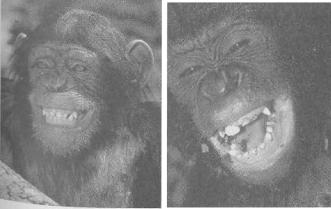
The Magic of Smiles and Laughter
that distinguish these smiles from genuine ones. When a smile is genuine, the fleshy part of the eye between the eyebrow and the eyelid - the eye cover fold - moves downwards and the end of the eyebrows dip slightly.
Smiling Is a Submission Signal
Smiling and laughing are universally considered to be signals that show a person is happy. We cry at birth, begin smiling at five weeks and laughing starts between the fourth and fifth months. Babies quickly learn that crying gets our attention - and that smiling keeps us there. Recent research with our closest primate cousins, the chimpanzees, has shown that smiling serves an even deeper, more primitive purpose.
To show they're aggressive, apes bare their lower fangs, warning that they can bite. Humans do exactly the same thing when they become aggressive by dropping or thrusting forward the lower lip because its main function is as a sheath to conceal the lower teeth. Chimpanzees have two types of smiles: one is an appeasement face, where one chimp shows submission to a dominant other. In this chimp smile - known as a 'fear face' - the lower jaw opens to expose the teeth and the corners of the mouth are pulled back and down, and this resembles the human smile.
A primate 'fear face' (left) and a primate 'play face'
69

The Definitive Book of Body Language
The other is a 'play face' where the teeth are exposed, the corners of the mouth and the eyes are drawn upwards and vocal sounds are made, similar to that of human laughing. In both cases, these smiles are used as submission gestures. The first communicates 'I am not a threat because, as you can see, I'm fearful of you' and the other says 'I am not a threat because, as you can see, I'm just like a playful child'. This is the same face pulled by a chimpanzee that is anxious or fearful that it may be attacked or injured by others. The zygomatics pull the corners of the mouth back horizontally or downwards and the orbicularis eye muscles don't move. And it's the same nervous smile used by a person who steps onto a busy road and almost gets killed by a bus. Because it's a fear reaction, they smile and say, 'Gee...I almost got killed!'
In humans, smiling serves much the same purpose as with other primates. It tells another person you are non-threatening and asks them to accept you on a personal level. Lack of smiling explains why many dominant individuals, such as Vladimir Putin, James Cagney, Clint Eastwood, Margaret Thatcher and Charles Bronson, always seem to look grumpy or aggressive and are rarely seen smiling - they simply don't want to appear in any way submissive.
And research in courtrooms shows that an apology offered with a smile incurs a lesser penalty than an apology without one. So Grandma was right.
Happy, submissive or about to tear you limb from limb?
70
The Magic of Smiles and Laughter
Why Smiling Is Contagious
The remarkable thing about a smile is that when you give it to someone,it causes them to reciprocate by returning the smile, even when you are both using fake smiles.
Professor Ulf Dimberg at Uppsala University, Sweden, conducted an experiment that revealed how your unconscious mind exerts direct control of your facial muscles. Using equipment that picks up electrical signals from muscle fibres, he measured the facial muscle activity on 120 volunteers while they were exposed to pictures of both happy and angry faces. They were told to make frowning, smiling or expressionless faces in response to what they saw. Sometimes the face they were told to attempt was the opposite of what they saw - meeting a smile with a frown, or a frown with a smile. The results showed that the volunteers did not have total control over their facial muscles. While it was easy to frown back at a picture of an angry man, it was much more difficult to pull a smile. Even though volunteers were trying consciously to control their natural reactions, the twitching in their facial muscles told a different story - they were mirroring the expressions they were seeing, even when they were trying not to.
Professor Ruth Campbell, from University College London, believes there is a 'mirror neuron' in the brain that triggers the part responsible for the recognition of faces and expressions and causes an instant mirroring reaction. In other words, whether we realise it or not, we automatically copy the facial expressions we see.
This is why regular smiling is important to have as a part of yourbody language repertoire, even when you don't feel like it, becausesmiling directly influences other people's attitudes and how they respond to you.
Science has proved that the more you smile, the more positive reactions others will give you.
71
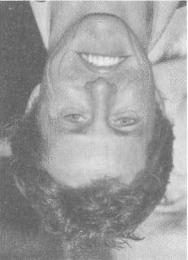
The Definitive Book of Body Language
In over 30 years of studying the sales and negotiating process we have found that smiling at the appropriate time, such as during the opening stages of a negotiating situation where people are sizing each other up, produces a positive response on both sides of the table that gives more successful outcomes and higher sales ratios.
How a Smile Tricks the Brain
The ability to decode smiles appears to be hardwired into the brain as an aid to survival. Because smiling is essentially a submission signal, ancestral men and women needed to be able to recognise whether an approaching stranger was friendly or aggressive, and those who failed to do this perished.
Do you recognise this actor?
When you look at the above photograph you'll probably identify actor Hugh Grant. When asked to describe his emotions in this shot, most people describe him as relaxed and happy because of his apparent smiling face. When the shot is turned the right way up, you get a completely different view of the emotional attitude conveyed.
72
